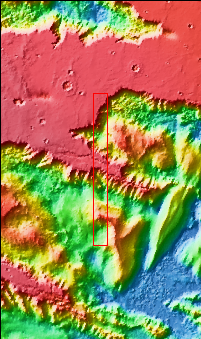
|
Ophir and Candor Chasmata
- Click the image above for a larger view
- Full-Res JPEG (1204 x 5318) (224.7 kB)
- Full-Res TIFF (1204 x 5318) (2.5 MB)
Caption:

Context image
Today’s VIS image shows parts of Ophir Chasma (top of image) and Candor Chasma (bottom of image). Both are part of Valles Marineris. Candor Chasma is approximately 810 km long (503 miles) and is divided into two regions — eastern and western Candor. This image is of western Candor Chasma. The floor of Candor Chasma includes a variety of landforms, including layered deposits, dunes, landslide deposits and steep sided cliffs and mesas. Many forms of erosion have shaped Candor Chasma. There is evidence of wind and water erosion, as well as significant gravity driven mass wasting (landslides). Ophir Chasma is approximately 317km long (197 miles). This image shows the western end of Ophir Chasma. A landslide is visible in Ophir Chasma.
Orbit Number: 82086 Latitude: -4.67658 Longitude: 285.773 Instrument: VIS Captured: 2020-06-16 06:38
Background Info:
Please see the THEMIS Data Citation Note for details on crediting THEMIS images.
NASA's Jet Propulsion Laboratory manages the 2001 Mars Odyssey mission for NASA's Science Mission Directorate, Washington, D.C. The Thermal Emission Imaging System (THEMIS) was developed by Arizona State University, Tempe, in collaboration with Raytheon Santa Barbara Remote Sensing. The THEMIS investigation is led by Dr. Philip Christensen at Arizona State University. Lockheed Martin Astronautics, Denver, is the prime contractor for the Odyssey project, and developed and built the orbiter. Mission operations are conducted jointly from Lockheed Martin and from JPL, a division of the California Institute of Technology in Pasadena.
Cataloging Keywords:
| Name | Value | Additional Values |
|---|---|---|
| Target | Mars | |
| System | ||
| Target Type | Planet | |
| Mission | 2001 Mars Odyssey | Mariner |
| Instrument Host | Mars Odyssey | |
| Host Type | Orbiter | Flyby Spacecraft |
| Instrument | Thermal Emission Imaging System (THEMIS) | |
| Detector | ||
| Extra Keywords | Dune, Grayscale, Thermal, Water | |
| Acquisition Date | ||
| Release Date | 2020-09-30 | |
| Date in Caption | 2020-06-16 | |
| Image Credit | NASA/JPL-Caltech/ASU | |
| Source | photojournal.jpl.nasa.gov/catalog/PIA24123 | |
| Identifier | PIA24123 | |
